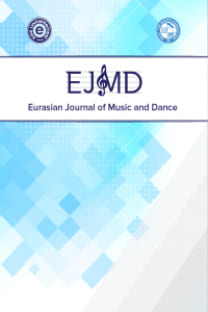DMİTRİ ŞOSTAKOVİÇ’İN 9. SENFONİSİ VE FAGOT SOLOLARININ İNCELENMESİ
20. yüzyılın önde gelen bestecilerinden Dmitri Şostakoviç, senfoni, film müziği, şarkı ve caz müziği dâhil olmak üzere pek çok türde eserler bestelemiş, hayatı boyunca üst düzey pek çok ödül ve nişana layık görülmüştür. 9. Senfonisini Sovyetler Birliği’nin Üçüncü Reich’e karşı kazanılan zaferinden sonra bestelemiştir. Mevcut olan iktidar tarafından Sovyet halkını kutlamak ve yüceltmek için besteleneceği umulmuştur. Ancak, eserin ilk seslendirilişinden sonra eserin Sovyet Partisi’nin beklentilerini karşılamayan görünüşte hafif, eğlenceli, küçük bir orkestra için kısa bir senfoni olduğu anlaşılmış ve büyük bir hayal kırıklığına neden olmuştur. Bu nedenle, asla sosyalist gerçekçiliğe yakışır ve zamanın ihtiyaçlarını karşılayan bir eser olarak görülmemiştir. Daha sonra bestecinin diğer birçok eseri ile birlikte yasaklanmıştır. Şostakoviç 9. Senfonisinde “müzikal şaka” aktarımı tekniğini kullanmıştır. Eserin dördüncü ve beşinci bölümünde yer alan fagot soloları, ulusal ve uluslararası orkestra sınavlarında karşılaşılan en önemli eserlerden biri olma niteliği taşır. Soloların doğru bir biçimde yorumlanması bilgi birikimini, müzikaliteyi ve teknik beceriyi gerektirir. Bu çalışmanın amacı, Dmitri Şostakoviç’in 9. Senfonisi hakkında genel bir bilgi verilmesi, fagot sololarının incelenmesi ve bu soloların yorumlanmasında karşılaşılan teknik ve müzikal zorluklar için çözüm önerilerinde bulunmaktır. Bu araştırma, Dmitri Şostakoviç’in 9. Senfonisi hakkında literatür taraması yapılan nitel bir araştırmadır.
Anahtar Kelimeler:
Dmitri Şostakoviç, 9. Senfoni, Senfoni, Fagot, Solo
Dmitri Shostakovich’s Symphony No. 9 and Analysis of the Bassoon Solos
Dmitri Shostakovich, one of the leading composers of the 20th century, has composed many kinds of works including symphonies, film music, songs, jazz music and has been rewarded many high-level awards and orders throughout his life. He composed his symphony No.9 after the victory of the Soviet Union against the Third Reich. By the present government, it was expected to be composed to celebrate and glorify the Soviet people. However, after the first premiere of the piece, it was understood that the piece was transparent, amusing, small in scale and a short symphony for an orchestra, it did not meet the expectations of the Soviet Party and it caused a great disappointment. For this reason, it has never been regarded as a work that befits socialist realism and meets the needs of the time. It was later banned along with many other works of the composer. Shostakovich used the “musical joke” technique in his 9th symphony. Bassoon solos, which are in the fourth and fifth movements of the work, are one of the most important works encountered in national and international orchestra auditions. Correct interpretation of solos requires knowledge, musicality and technical skills. The aim of this study is to provide general information about the Dmitri Shostakovich’s Symphony No.9, to examine bassoon solos and to propose solutions for the technical and musical difficulties encountered in the interpretation of these solos. This research is a qualitative research that has been made a literature review on the Dmitri Shostakovich’s Symphony No.9.
Keywords:
Dmitri Shostakovich, Symphony No. 9, Symphony, Bassoon, Solo,
___
- Akan, M. (2017). Sosyalist Gerçekçilik Üzerine Kısa Bir Değerlendirme. Itıl Suwı Aka Turur. Ed. U. Üren-D. Çatalkılıç, İzmir: Ege Üniversitesi Basımevi, 371-382.
- Ayan, M. (2016). 20. Yüzyıl Batı Sanatında İdeolojik Yaklaşım Olarak “Sosyalist Gerçekçilik” ve “Faşizm”. Erişim tarihi: 2 Şubat, 2020, http://mujdeayan.com/HM/tr_TR/yayinlar/sosyalist-gercekcilik-ve-fasizm/
- Ayvazoğlu, A. (2016). Tarihsel Süreç İçerisinde Dmitri Shostakovich' in 7. Senfonisi'nin İncelenmesi, (Yayımlanmamış yüksek lisans tezi), T.C. Yaşar Üniversitesi, İzmir.
- Büke, A. (2015, 27 Şubat). Kuşatmanın Senfonisi. Erişim Tarihi: 15 Ocak, 2020. https://www.insanokur.org/kusatmanin-senfonisi/
- Fay, L. (2000). A life: Shostakovich. New York: Oxford University Press.
- Gansbeke, B. V. (2012). The Orchestral Bassoon: A Pedagogical Website for Bassoonists, Submitted to the faculty of the Jacobs School of Music in partial fulfillment of the requirements for the degree, Doctor of Music, Indiana University.
- Huang, H-H. (2004). Bassoon Pedagogy of Orchestral Excerpts: Teaching Interpretation in Excerpts through the Study of Recordings. A document proposal submitted to the Document Committee of the College-Conservatory of Music in partial fulfillment of the requirements for the degree of Doctoral of Musical Arts, University of Cincinnati.
- Kacıroğlu, M. (2016). Cumhuriyet Dönemi Türk Edebiyatında (1923–1940) Toplumcu-Gerçekçi Edebiyat Tartışmaları, ETÜ, Sosyal Bilimler Enstitüsü Dergisi, I/2, 27-71.
- Lee, D. (2002). Masterworks of 20th-Century Music, Routledge New York – London.
- Lenberg, P. (2016) Shostakovich’s Ninth Symphony: An Analytical Exploration and Keys to Interpretation. A Doctoral Document Submitted in Partial Fulfillment of the Requirements for the Doctor of Musical Arts, University of Nevada, Las Vegas.
- Longazo, G. (1969). The Bassoon: Its Use in Selected Works of Shostakovich, Stravinsky and Schoenberg. A Dissertation Presented to the Faculty of the School of Music Universıty of Southern California in Partial Fulfillment of the Requirements for the Degree Doctor of Musical Arts.
- Martynov, I. (1942). Shostakovich: The Man and His Work. Philosophical Library, New York.
- Moshevich, S. (2004) Dmitri Shostakovich, Pianist. Montreal: McGill-Queen's University.
- Sever, D. (2016). D.D. Şostakoviç'in Piyano Eserlerinden 24 Prelüt ve Füg'ün Müzik Edebiyatındaki Yeri ve J.S.Bach' ın 48 Prelüt ve Füg'ü ile Kontrpuan Açısından Karşılaştırılması. Sanatta Yeterlik Tezi, İstanbul Üniversitesi Sosyal Bilimler Enstitüsü.
- Tekiner, H. (2012). Şostakoviç'in Nörolojik Hastalığı. Andante 2012, 9/70, 64-65.
- ISSN: 2651-4818
- Yayın Aralığı: Yılda 2 Sayı
- Başlangıç: 2011
- Yayıncı: Ege Üniversitesi
Sayıdaki Diğer Makaleler
KEMAN CİLASINDA ‘GELENEKSEL YÖNTEM’ VE ALKOL BAZLI CİLA İÇİN BİR UYGULAMA ÖRNEĞİ
Attila ÖZDEK, Sami Emrah GEREKTEN
BİR KÜLTÜRÜN DÖNÜŞÜMÜ: “POSTTÜRKÜ”
Banu MUSTAN DÖNMEZ, Mehmet Emin ŞEN
MÜZİK ÖĞRETMENİ ADAYLARININ OKUL ÖNCESİ MÜZİK EĞİTİMİ YETERLİKLERİNE İLİŞKİN GÖRÜŞLERİ
Sultan Gülşah FİDAN, Mehmet Can ÇİFTÇİBAŞI, Zeynel TURAN
Geleneksel Türk Sanat Müziğinde Çalgısal Biçimler ve Türler: “Çalgısal Semâî” Üzerine Bir Tartışma
TOPLUMSAL CİNSİYET VE DANS: İZMİR İLİ ÖDEMİŞ İLÇESİ GELENEKSEL KADIN OYUNLARI
